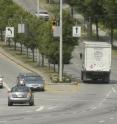Stop or speed through a yellow light? That is the question
Engineering graduate student Zhixia Li was attracted to UC because of the real-world education and experience the university provides. In return, he's headed a real-world project that every driver can relate to: the "yellow light dilemma." Are you, as a driver, more likely to stop or speed through a yellow light? Transportation engineering PhD student Zhixia Li was attracted to the University of Cincinnati because of the real-world education and experience the university provides. In return, he's headed a real-world project that every driver can relate to.
It's a project on which he has presented and published nationally, and it looks at what he calls the "yellow light dilemma." Are you, as a driver, more likely to stop or to speed through a yellow light?
Here's what he found when conducting research, in cooperation with the Ohio Department of Transportation, at intersections in Akron, Cleves and Fairfield, Ohio: Certain factors make it more likely that you'll opt to speed through an intersection rather than stop at the light.
The results of his research with his advisor Prof. Heng Wei, "Analysis of Drivers' Stopping Behaviors Associated with the Yellow Phase Dilemma Zone — An Empirical Study in Fairfield, OH," will be presented at the 2010 American Society of Highway Engineers National Conference on June 9-13, 2010, in Cincinnati, at the Hilton Cincinnati Netherland Plaza.
So what are the factors that make us run the yellow? These include
- Lane position: Drivers in the right lane are 1.6 times more likely to speed through a yellow light as compared to drivers in the left lane.
- Type of vehicle: Drivers in heavy trucks are more likely to "pass through" a yellow light versus drivers of automobiles, SUVs, vans or pickup trucks.
- Travel speed and speed limit: The greater the traveling speed of a vehicle at the onset of a yellow light, the more likely that vehicle is to pass through a yellow light. Another finding: the higher the posted speed limit, the more likely vehicles are to pass through a yellow light.
- Timing of light: Yellow lights are typically set to persist between 3 to 5 seconds. Drivers coming upon an intersection where the yellow light persists longer are more likely to pass through the yellow light. For each "additional" second a yellow light persists, drivers are more than three times as likely to pass through an intersection. So, for example, a driver is more than three times as likely to pass through a yellow light set to persist for 5 seconds versus a yellow light set to persist for 4 seconds. Ditto for a yellow light that persists for 4 seconds versus a yellow light that persists for 3 seconds.
This UC research will help traffic engineers consider and test safety and traffic efficiency measures, including the positioning of sensors that time traffic lights.
And it just might help drivers consider their own actions when in the yellow light dilemma zone.
Source: University of Cincinnati
Other sources
- Stop or speed through a yellow light? That is the questionfrom PhysorgTue, 8 Jun 2010, 22:30:50 UTC
- Stop or speed through a yellow light? That is the questionfrom Science BlogTue, 8 Jun 2010, 22:00:37 UTC
